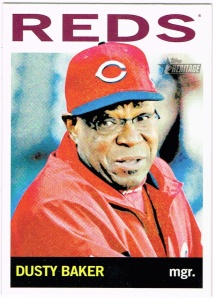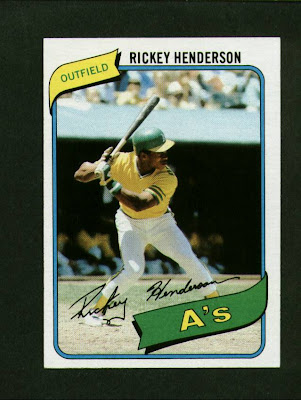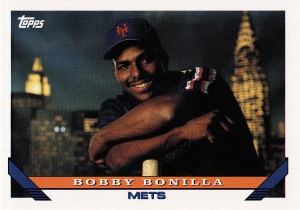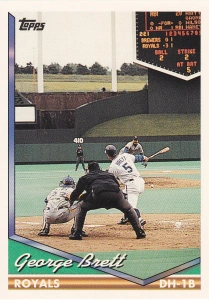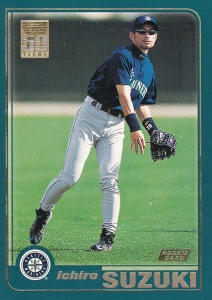Up next in the Great Heritage Comparison – All-Star Rookies. These cards feature players from the ASR team the year before. So we’re comparing the 1963 ASR team to the 2012 team. On the 1964 cards, compared to the 2013 Heritage version. All pretty simple until someone gets hurt. This should be a pretty fun comparison – the 1963 team has the all-time hit king on it. I’m pretty sure Heritage will come away with an advantage here, however; last year’s team was probably the best rookie crop in history.
I’m comparing by position, not by card number. Last year, the 10 players all have the same 10 card numbers (yay, Topps, yay!), but more often than not, Topps didn’t match up the card numbers at each position. This year, they don’t even have the same card numbers in all instances (boo, Topps, boo!), but they do in some (crickets). One other thing to note, the 2012 set has an extra pitcher as they now select a relief pitcher.
I’m giving an additional bonus point to the team I deem the best overall at the end of the ASR team. This will be over three posts to break it up into 3-4-3 cards per post (batter, infield, outfield). Unlike the other comparisons, I’ll base my picks mostly on how good their rookie year was, though card picture will be a secondary consideration.
Catcher

 This matchup features Wilin Rosario of the Rockies against Jesse Gonder of the Mets. Gonder actually played a few games in 1960, 61 and 62, but was still rookie eligible in 1963, when he was traded from the Reds to the Mets. Gonder was a left-handed hitter, which is a bonus as a catcher, though it seems he platooned most of his career, as 1964 would be the only season he played more than 85 games. In 1963, he hit .304 combined for the Reds and Mets; ’63 and ’64 were easily his best 2 seasons. The 1964 card doesn’t have the All-Star Rookie trophy by mistake.
This matchup features Wilin Rosario of the Rockies against Jesse Gonder of the Mets. Gonder actually played a few games in 1960, 61 and 62, but was still rookie eligible in 1963, when he was traded from the Reds to the Mets. Gonder was a left-handed hitter, which is a bonus as a catcher, though it seems he platooned most of his career, as 1964 would be the only season he played more than 85 games. In 1963, he hit .304 combined for the Reds and Mets; ’63 and ’64 were easily his best 2 seasons. The 1964 card doesn’t have the All-Star Rookie trophy by mistake.
Rosario on the other hand appears as though he’s going to be an everyday catcher. In 2012, he hit 28 homers in just under 400 at bats, and earned 4th place in the RoY voting in one of the most stacked rookie classes I can ever remember. These cards are a total non-match; Gonder is card #457 (Latos in Heritage), while Rosario is card #488 (Yankees rookies in ’64 Topps).
1963 Topps – Jesse Gonder (.304/6/20, 167 PA’s)
Trivia: Who was the oldest batting champ?
Answer: Ted Williams, 39 hit .388 in 1957.
2012 Heritage – Wilin Rosario (.270/28/71, 426 PA’s)
Trivia on Rosario’s card is a repeat.
Winner – Rosario. He easily had better overall numbers in his rookie year, in fact, it’s one of the better rookie years by a catcher in my lifetime (Piazza and Santiago jump out as better). He’s already hit more career homers than Gonder. I like the picture better on Gonder’s card, but I’ve also got to ding that one for not having the ASR trophy.
**********
Pitcher
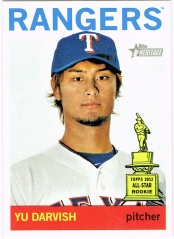
 Ray Culp / Yu Darvish here. This is actually a great matchup. Both pitchers finished 3rd in their respective league’s RoY voting, and both pitchers made the All-Star team as rookie starting pitchers. Culp went 14-11 with an ERA under 3 as the Phillies best pitcher. Culp had a pretty good career, winning 122 games (14 games or more 6x) and even making on more All-Star team. Culp is on card #412, which matches up with Casey Janssen, who is a pitcher but wasn’t on the ASR team.
Ray Culp / Yu Darvish here. This is actually a great matchup. Both pitchers finished 3rd in their respective league’s RoY voting, and both pitchers made the All-Star team as rookie starting pitchers. Culp went 14-11 with an ERA under 3 as the Phillies best pitcher. Culp had a pretty good career, winning 122 games (14 games or more 6x) and even making on more All-Star team. Culp is on card #412, which matches up with Casey Janssen, who is a pitcher but wasn’t on the ASR team.
Darvish went 16-9 with a 3.90 ERA in the offensive laden AL West. He would have been a contender for RoY in many other seasons. He had a lot of hype, and certainly got very close to living up. The Darvish card matches up with Pete Rose as card #125 – so they both have the trophy at least.

 The LHP spot is also a very good matchup, and in fact features guys who were even better than Darvish or Culp. Gary Peters of the White Sox was the 1963 member of the ASR team. Peters went 19-8, led the league in ERA, was 8th in MVP voting and won the AL Rookie of the Year. Peters also had a pretty solid career, winning 124 games, winning 2 ERA titles and leading the league with 20 wins in 1964. Peters is on card #130, which matches up with Philip Umber – who wasn’t an ASR team member but was on the White Sox. But he signed with Houston in the offseason.
The LHP spot is also a very good matchup, and in fact features guys who were even better than Darvish or Culp. Gary Peters of the White Sox was the 1963 member of the ASR team. Peters went 19-8, led the league in ERA, was 8th in MVP voting and won the AL Rookie of the Year. Peters also had a pretty solid career, winning 124 games, winning 2 ERA titles and leading the league with 20 wins in 1964. Peters is on card #130, which matches up with Philip Umber – who wasn’t an ASR team member but was on the White Sox. But he signed with Houston in the offseason.
Peters was impressive, but he’s got good competition. Miley was runner-up for the NL Rookie of the Year, and almost won the award over Bryce Harper. Miley went 16-11 with a 3.33 ERA for the Diamondbacks. Miley has card #474, and there’s no connection with him and Larry Sherry other than them both being pitchers.
1963 Topps – Culp (14-11/2.97/176, 203 IP)
Trivia: Which team scored 15 runs in the first inning?
Answer: The LA Dodgers in 1952 (they weren’t in LA at the time – but that’s what the card says).
Peters (19-8/2.33/189, 243 IP – AL RoY)
Trivia: When was the National League formed?
Answer: 1876.
2012 Heritage – Darvish (16-9/3.90/221, 191 IP)
Trivia: Who was the last NL player with a 4-HR game?
Answer: Shawn Green, Dodgers, May 23, 2002.
Miley (16-11/3.33/144, 195 IP)
Trivia: Which two men tied for the NL HR crown in consecutive years?
Answer: Ralph Kiner & Johnny Mize, ’47 & ’48.
Winner – Split. I’m giving Heritage the win for Darvish in a very close matchup. The ERA looks much higher, but he actually had a better season than Culp if you look at any value metric. And his team made the playoffs, though they did have a pretty epic collapse to blow the division title. Plus, I just don’t like the Culp photo.
But Peters definitely has to have the win over Miley. I like the picture on both cards, but Peters was the Rookie of the Year winner and led the league in ERA. They only did one Cy Young (not one in each league) back then, and Sandy Koufax was the unanimous winner, but Peters would have vied for the American League award if it existed. Miley was good, but not that good.
2013 Heritage leads, 8-7


























